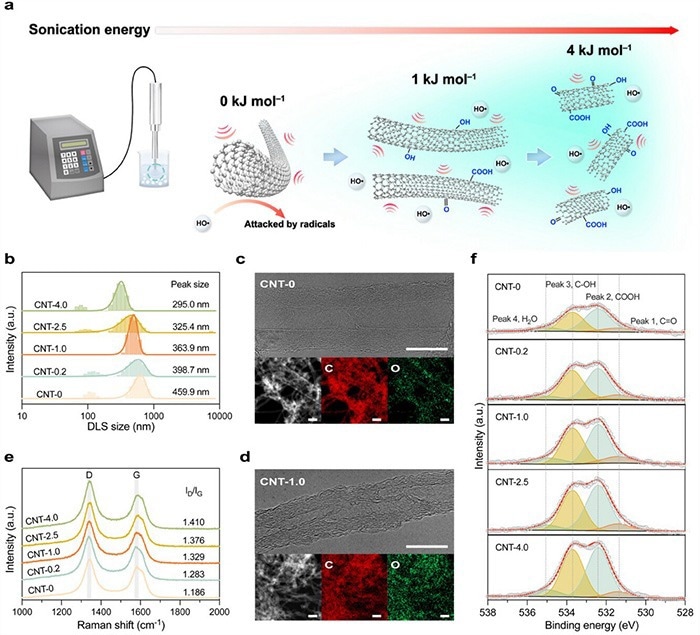Reviewed by Lexie CornerJun 6 2025
Researchers at Tohoku University used sonicated carbon nanotubes (CNTs) to enable a reaction pathway that can detect and break down specific contaminants. This approach could support efforts to clean polluted water.
 Synthesis and characterization of sonicated CNT catalysts. a) Schematic illustration of the synthesis of sonicated CNT catalysts. b) Size distribution of sonicated CNT catalysts determined by DLS. Morphology and chemical composition of c) CNT-0 and d) CNT-1.0 in TEM images (scale bar = 10 nm) and the corresponding EDX mappings (scale bar = 20 nm). e) Raman and f) O 1s XPS spectra of sonicated CNT catalysts. Image Credit: Xin Yang et al.
Synthesis and characterization of sonicated CNT catalysts. a) Schematic illustration of the synthesis of sonicated CNT catalysts. b) Size distribution of sonicated CNT catalysts determined by DLS. Morphology and chemical composition of c) CNT-0 and d) CNT-1.0 in TEM images (scale bar = 10 nm) and the corresponding EDX mappings (scale bar = 20 nm). e) Raman and f) O 1s XPS spectra of sonicated CNT catalysts. Image Credit: Xin Yang et al.
Freshwater is essential for people, animals, and plants. However, it is often contaminated by runoff from rain and surface water. The global water supply is limited, and demand is increasing, making it important to reduce waste and protect existing sources.
Advanced oxidation processes (AOPs) offer one way to treat polluted water and help restore it to a usable state.
Previously used AOP methods were nonselective and degraded both pollutants and background water constituents indiscriminately. Our method overcomes this by using a more selective nonradical pathway.
Hao Li, Professor, Advanced Institute for Materials Research, Tohoku University
The nonradical pathway uses singlet oxygen and rapid, direct electron transfer. This method removes common industrial and municipal pollutants within five minutes at a rate of 4.80 µmol g⁻¹ s⁻¹. It remains effective under a range of water conditions, including different pH levels and varying amounts of organic matter.
Li added, “Another benefit of our method is that the catalysts produced can be scaled up, they show superior catalytic performance, and are easily integrated into flat membranes and hollow fiber devices for continuous water filtration. This makes the technology practical and adaptable for real-world applications.”
Centralized treatment plants are expensive and often rely on multi-step, complex processes. The approach proposed in this study is designed to treat distributed water sources, such as stormwater or river water, at the point of use. Solid oxidants used in advanced oxidation processes (AOPs) can be stored and transported easily, making them suitable for direct application at the site of contamination.
The next phase of the project will focus on improving the long-term stability of the catalysts and their resistance to fouling in real water environments. The team also aims to expand the method’s effectiveness against a wider range of contaminants, particularly electron-deficient organics. In addition, further development of the catalysts’ surface functional groups is planned to enhance catalytic performance.
This approach represents a promising development in freshwater treatment technologies.
The Digital Catalysis Platform (DigCat), developed by the Hao Li Lab, is the largest catalysis platform and database to date. It contains the key data used in this research.
Journal Reference:
Yang, X., et al. (2025). Sonicated Carbon Nanotube Catalysts for Efficient Point‐of‐use Water Treatment. Advanced Materials. doi.org/10.1002/adma.202504618.